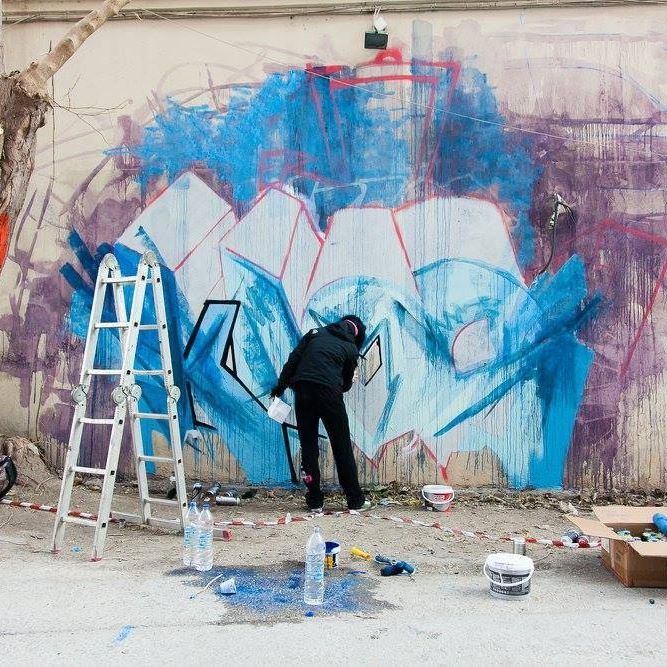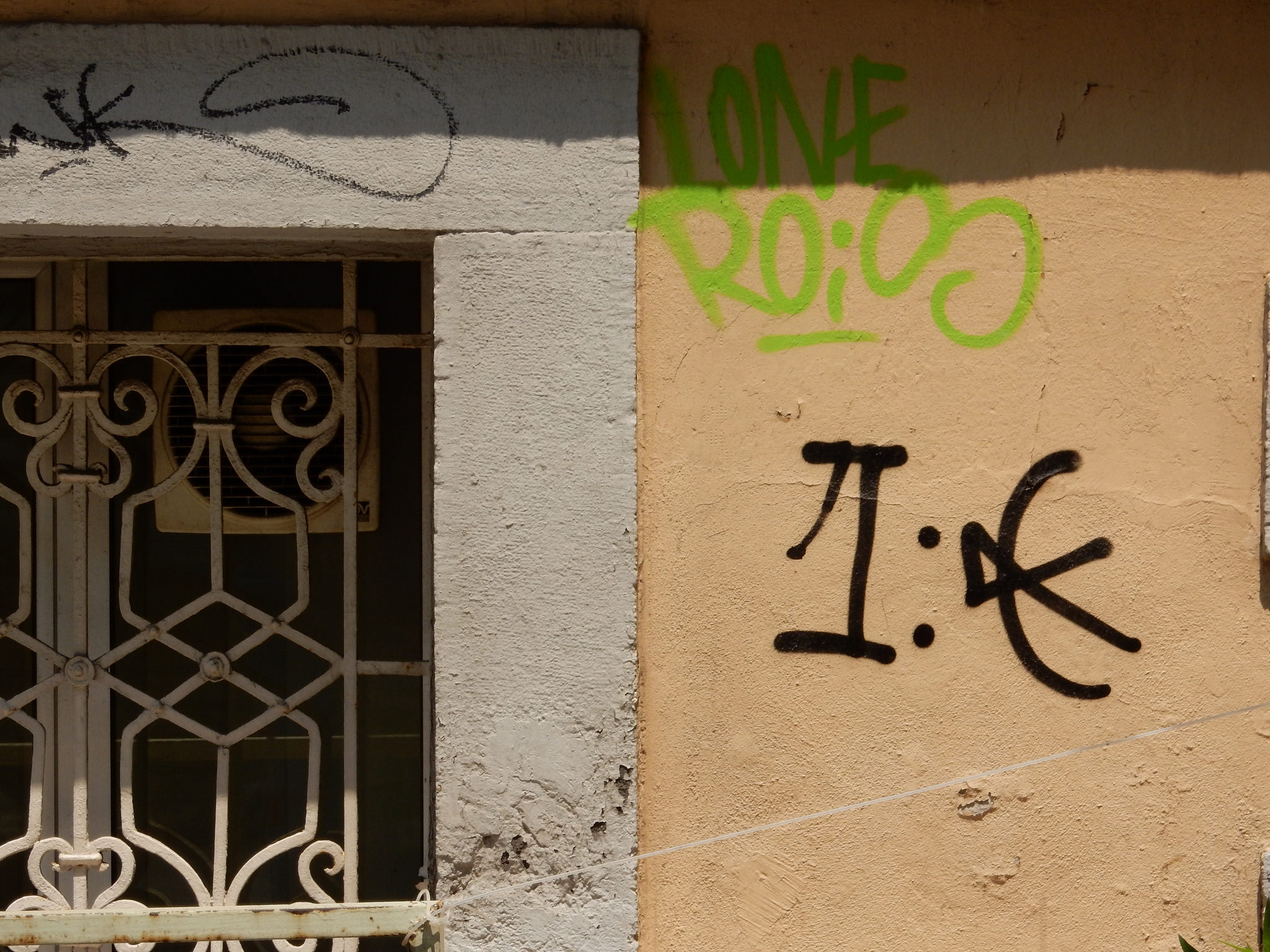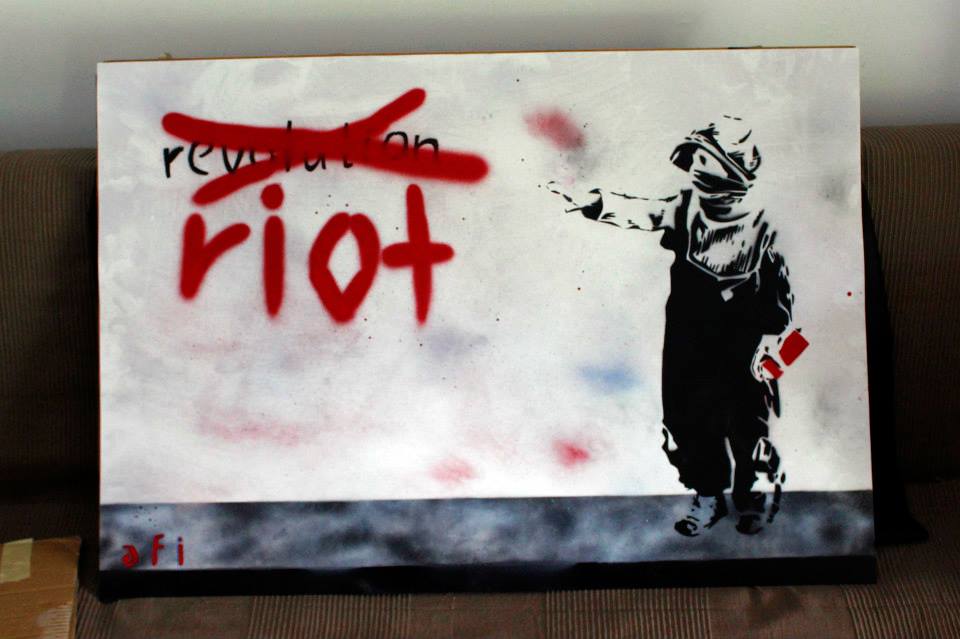My first encounter with the short Spanish girl that goes by Galldindie was quite lucky: I found her spraying a wall in Exarcheia while I was just showing my new roommate the neighborhood. Naturally, I had to chat her up about the huge lion she was just painting. I found out she was an art and architecture student from Barcelona just halfway through her one-year Erasmus stay in Athens and just as intrigued with the city as I was. She even made a paste-up project about it, that I wrote about here. I later got to interview her on my very own rooftop terrace in Exarcheia, where she told me about her interest in space, the differences between Barcelona and Athens, the crisis, and her fascination with all things to do with carnival. An overview of her multifaceted artistic work can be found on her blog.
Could you tell me about how you first started out doing street art and how that progressed over time.
I always liked to draw and paint a lot. I just realized that you can work really quickly with spray paint. I also like the fact that with street art the people have something to do with your work. It’s not like when I paint something and I paint it only for me. I paint it on canvas and i paint it because I need to and I don’t care if somebody will see it someday. In this moment I have the need to express what I’m feeling and I paint it and it’s okay. But street art is different, every sketch is important, you know, because I know that other people will see it.
Does the style of the artworks you do in Athens differ from what you do in Barcelona?
No, I don’t think so. Because if I look at my work and all the different things I do, there is not a clear style. I try a lot of different ways, a lot of different techniques and I always have a different result. also because maybe throughout all of these years I never had a time to completely dedicate myself fully to something, to start a creative process and develop it over time. It’s more that I find something that I’m interested in, I try it a little bit, I do some things and then I find another thing that I also like and I also do it. Like picking things from everywhere. In the end it’s picking from everywhere and picking from nowhere.
Do you ever do paid commissions, like shopfronts or something?
Yeah, sure. Here in Athens when you are painting in the street a lot of people come to you and tell you: I like it a lot. There’s people that say thank you for doing this and this is crazy in my mind! Because in Barcelona if they see you’re painting, they just call the police. And I am very grateful when somebody comes to me and says thank you for what you’re doing because I will pass through here every day, this is my way home and this thing that you are doing will come into my life. And this is crazy! I mean for me it’s the best reward you can have, for sure.
What else is different about Barcelona?
It’s a big scene but that was mostly before the new law that came in 2006, I think. The attitude against street art is much more strict now. They started cleaning a lot of walls at first and try to find artists. They still do it in the times of crisis. I think the Greek society is much more free than the Spanish society. People here are much more independent from authority. You feel that somehow they come from this people that used to talk about philosophy every day, I like it a lot.
Do you also paint outside Exarcheia?
Yes, I have stuff in Metaxourgio. I painted my first piece close to this famous bar, Anthropos. There is this empty house and it has a little garden and I went in there and painted. I did it there because it was a little inside and I was not sure if I could do it in the plain light in the street. My flatmates came with me because they didn’t have anything to do.
Tell me about the Invisible Architectures project, how many pieces did you make?
I have 6 drawings just one of each and they are all handmade. And each one is meant for a specific place and situation. It’s not like a stencil for example. When you make a stencil you chose a message and you reproduce it in order for as many people as possible to see it so your message will reach the people. Invisible Architectures is different. I chose some situations that speak about Athens for me and then I drew the picture to make these temporary situations permanent. Permanent somehow because of course it is paper and so it will wear off. I also like that because I don’t want to pretend to modify the heart of all these invisible architectures. I first found the situation and then made the artwork and I think this has a lot to do with architecture: first comes the place and then the thing you put there.
Have you ever worked on a project that is similar to this one?
No. But I’m really happy with this because it also has a lot to do with architecture, about this conception of public space and how people need to customize the space and make it personal. It’s not only about art but also architecture, like a sum-up of different things.
How do you do find the space for an artwork, like that time we met in the street?
This one was different. The wall was very good because it was already really dirty which I really like. I never do background, mostly I only have the picture and it goes completely on the existing background. And then I try to find beautiful backgrounds that already exist. And with this one I liked that it was so completely full of dirty old posters and a lot of tags, it is very heterogeneous.
You seem to often use themes of carnival, does that have a special meaning to you?
I like everything that has to do with carnival a lot, with theatre and dressing up. These days I’m drawing a lot about how people are acting in life. Honesty is very important for me and I like people who don’t pretend anything. And for me one of the big problems of this world is people pretending to be something they are not and not being natural, superficiality. So then I always choose these characters about the carnival because those are little worlds where you are not yourself, you are acting. also I like to play with sad characters most of the time. The circus is supposed to be a funny thing but we are fed up with playing this role that we have to play. Why should I pretend I’m happy with my house, my car, my dog when I’m not? It’s like the clown that doesn’t want to smile anymore. This is definitely influenced by the crisis.
Do you have anything to add about how Athens compares to Barcelona, perhaps keeping in mind the context of the crisis.
I think here it is completely opposite. If you don’t have a job you don’t have money and then you say okay, instead of sitting at home complaining about how little I am I will go out and do something with my neighbor who is in the same situation as I am. They have this mentality: we are all fucked up but there is a solution and we have to find it together. I like this collective thought. Things are much more individualistic in Barcelona. People who are still doing okay don’t realize that things are going completely down the drain.
—
This interview was conducted in person on April 9, 2013.
Questions by Julia Tulke.









